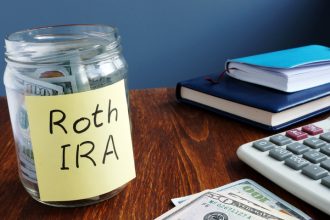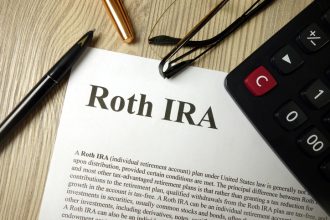If you have an employer-sponsored retirement plan, like a 403(b), leaving your job means you’ll need to decide what to do with your account.
When retiring, you have three main options: You can retain your old 403(b) if the plan allows it, roll your money over into an IRA or a Roth IRA, o4 withdraw your money and put it into a taxed portfolio. If you’re unsure which option is right for you, consider connecting with a fiduciary financial advisor and talking it over.
What Is A 403(b)?
A 403(b) is a tax-advantaged retirement plan offered by public schools, 503(c)(3) charities and some faith-based organizations.
These employer-sponsored retirement plans are very similar to 401(k)s – in fact, the two types of accounts are almost identical. With a 403(b), you can automatically contribute pre-tax money from each paycheck into your retirement portfolio. You receive a tax deduction for these contributions, which are capped at the same level as 401(k)s ($23,000 in 2024) Meanwhile, your employer can also make matching contributions at their discretion.
Once you turn 59 ½ or meet certain special circumstances, you can make withdrawals from your 403(b) but you’ll pay income taxes on all distributions, including the underlying principal. There is an additional 10% tax penalty for nonqualified distributions taken before this age.
In practice, there are two main differences between a 403(b) and a 401(k). First, employer contributions tend to be much lower with a 403(b). This is in part because of the nature of participants and the tighter budgets that nonprofits tend to have. Second, 403(b) plans can only offer annuities and mutual funds while a 401(k) can offer a much wider range of investment options. In practice, this means that 403(b) plans tend to invest heavily in annuities and are often administered by insurance companies.
403(b) Accounts and RMDs
By investing heavily in annuities, a 403(b) can change the math on required minimum distributions (RMDs).
All pre-tax accounts, like the 403(b), are subject to required minimum distributions (RMDs) once you turn 73. However, annuity contracts within a 403(b) can affect RMD calculations differently based on the nature of the asset. In general, there are three main cases: First, annuity contracts in annuitization typically do not count toward your portfolio’s value for the purposes of RMD calculations. Instead, the annuity’s income is considered sufficient to meet the contract’s minimum distribution.
Second, annuity contracts not yet in annuitization do typically count toward the value of your portfolio for the purposes of RMDs. If you turn 73 with significant annuity holdings that have not yet entered the payment phase, you may need to sell more liquid assets to satisfy your RMD.
Third, there is a special category of annuity called a qualified longevity annuity contract (QLAC). As long as you begin taking income from a QLAC before age 85, it will not be included in the value of your portfolio’s RMD.
If you need help planning for RMDs or deciding what to do with an old retirement account, consider working with a financial advisor.
Retiring With a 403(b)

When you retire, your options for a 403(b) are generally the same as with a 401(k). The same is true of moving on to a new employer, but with the additional option of rolling your existing 403(b) into your new employer’s retirement plan. In the case of retirement, you have three main options that you can apply in whole or in part:
1. Leave Your Money In Place
First, you can leave your money invested in the 403(b) and take distributions over time.
This is often an effective option with 403(b) plans. Since 403(b) plans tend to invest heavily in retirement annuities, your portfolio is likely to be structured around long-term or lifetime income. This can make leaving your plan in place a strong option compared with something like a 401(k) holding bonds and equities that need more management.
This can also be a good option if your 403(b) plan offers particularly strong investments or favorable terms for plan participants.
All of that said, this option will depend on the rules of your specific plan and its administrator. Your 403(b) may not allow former employees to stay invested or you simply may not want to stay entangled with former employers. You also may want to avoid the risk of future changes to the plan, its terms or its administrator.
2. Roll Over Your Money into an IRA
Moving your money to an IRA is a common choice for retirees with an employer-sponsored retirement plan. The main advantage is that it gives you control over your assets. With an IRA, you don’t have to keep a lifetime relationship with your former employer and you aren’t subject to any future changes they or their administrators make.
The first way to do this is by rolling over your money to a traditional IRA. This has no immediate tax implications, since you will be moving your money from one pre-tax portfolio to another. However, it’s important to make sure that there are no restrictions on any individual assets that would force you to cash out or otherwise withdraw from those investments. This portfolio will then be subject to the same income taxes and RMD requirements as the original 403(b).
The second option is to convert your money into a Roth IRA. If you do this, you will owe income taxes on the full value of this conversion in the year you make it. As long as you are older than 59 ½ you can take cash to pay those taxes from your retirement account. Also, if you are currently entering retirement, make sure to hold some money back as the IRS does not allow you to withdraw converted funds for five years (if you’re under 59 ½ years old).
Once you convert money to a Roth IRA, qualified withdrawals can be made tax free. You will pay no taxes on future withdrawals, nor will it be subject to RMD requirements. The result tends to be a high up front cost in exchange for significant long-term value.
Keep in mind that you don’t have to do this on you own. A financial advisor can help you complete an IRA rollover and then manage your account from then on.
3. Move Assets to a Taxable Portfolio
Finally, you can move your assets from your 403(b) to a standard brokerage account with no special tax status. This is otherwise known taking a “total distribution.” As with moving your money to an IRA, given the significant presence of annuity contracts in a 403(b) plan, make sure that you actually can transfer or cash out all of your assets.
Taking a total distribution is generally seen as the worst of your available options. As with a Roth IRA, you will need to pay income taxes on the entire amount in the year that you take the distribution.
Once you cash out your assets and reinvest them in a taxable account, the tax status of any future withdrawals will be based on the nature of the underlying assets. For example, if you hold a bundle of equities, you will generally only pay capital gains taxes on their returns going forward and won’t retain the tax-deferred status of a 403(b).
If you’re considering this option, a financial advisor can help you build a new investment portfolio based on your needs and goals.
Bottom Line

When you retire, it’s important to decide what to do with your employer-sponsored retirement plan. In general, you have three options for your 403(b): you can leave your account with your former employer, move it to an IRA or cash it out entirely and potentially reinvest the money in a taxable brokerage account.
Tips for Saving for Retirement
- How much money will you have when it’s time to retire? It’s a difficult question to answer but SmartAsset’s retirement calculator can help you estimate how much your savings could be worth by the time your golden years arrive. The free tool can also calculate how much you’ll need to support your projected expenses in retirement.
- A financial advisor can help you plan and save for retirement. Finding a financial advisor doesn’t have to be hard. SmartAsset’s free tool matches you with up to three vetted financial advisors who serve your area, and you can have a free introductory call with your advisor matches to decide which one you feel is right for you. If you’re ready to find an advisor who can help you achieve your financial goals, get started now.
Photo credit: ©iStock.com/PeopleImages, ©iStock.com/Vadym Pastukh, ©iStock.com/Chainarong Prasertthai
Read the full article here
















